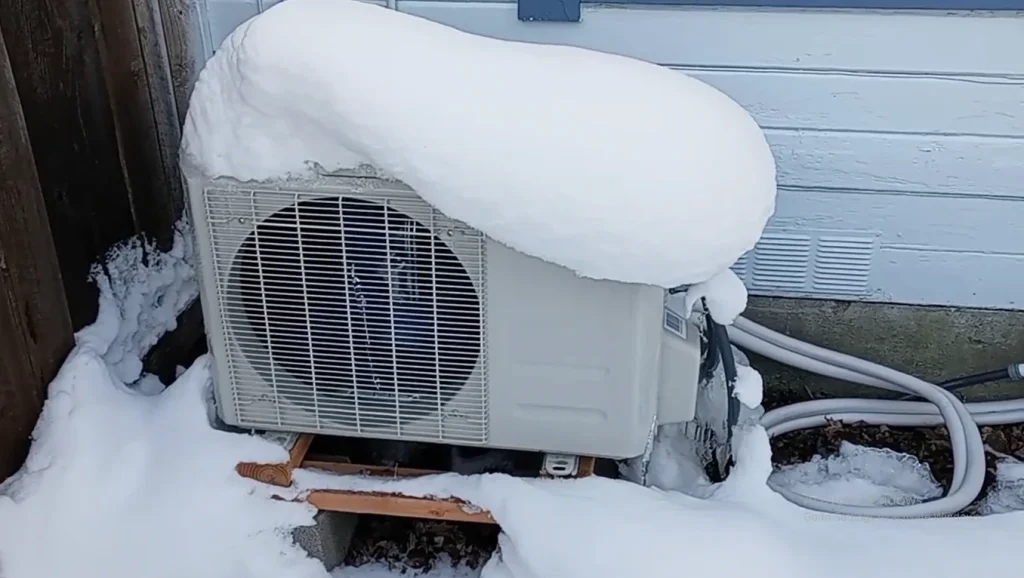A ductless mini-split HVAC system effectively keeps your home or workplace warm during cold months by distributing heat without needing ducts or a centralized network. It adjusts its heating output based on outdoor temperature extremes.
Even as temps drop, it continues to function, though its heating capacity may decrease at the lower limit. For extra performance in cold weather, auxiliary backup elements kick in.
Regular maintenance is key to ensuring the optimal operation and efficiency of the system. Proper insulation in walls, attics, and windows helps the mini-split manage heat transfer. With professional care at least once a year, your home stays comfortably warm despite the weather.
Heating and Cooling Efficiency of Mini Splits
When considering how a Mini split system can provide both heat and cool air for your home, it’s essential to understand the different types available. Low ambient models are specially-designed to operate efficiently at low temperatures, even down to 0°F. These systems maintain 100 percent efficiency with minimal decreased efficiency in cold climates, making them a reliable choice for much of the year.

For those living in areas where winters can be harsh, a mid-level model with a base pan heater may be required, as it ensures heating in moderate conditions down to 20°F. On the other hand, an economy-level model is best for warm climates, operating effectively until 30°F before it may shut off below 20°F.
The brand and model you choose will greatly impact performance, especially if you’re considering air conditioners versus heat pumps.
Also Read: Why does my mini split keep getting mold
Outdoor Unit Installation in Cold Weather Areas
When installing an outdoor unit in cold weather areas, it’s essential to consider the placement and positioning of the condenser. The unit must be elevated high off the ground to stay above the anticipated snowfall to ensure that it operates correctly during the winter. Proper spacing should be maintained to allow air to be circulated and drawn into the unit, preventing issues with snow and ice building up.

A good practice is to place the unit under an overhang or roof shelter to further protect it. Additionally, make sure there’s enough clearance around the unit so that it can operate efficiently and maintain a comfortable room temperature even in freezing conditions. Also read detailed artilce on where should AC be installed.
Improving Heating Function in Cold Climates
It’s common for frost to build up on the outdoor coil in extreme weather. To maintain optimal performance, the condenser needs to switch to defrost mode periodically, allowing the frost to melt and drip into the drain pan.
However, if the dripping water freezes before it can escape, ice buildup can become thick enough to freeze the fan blades or even cause frozen water to expand within the fins of the coil, potentially cracking it. This kind of damage can lead to expensive repairs—sometimes costing as much as $1,000.

To prevent damage to your mini split in subfreezing temperatures, using a heater designed for the drain pan is highly recommended. This heater is connected directly to the control board of the outdoor condenser, which automatically signals it to turn on when freezing is likely.
This setup helps protect the system by preventing ice buildup and keeping the coil and other components safe from potential harm. It’s important to choose a specific brand and model that is compatible with your mini split system.
Improving Cooling Function in Cold Climates
When dealing with cold-weather climates, keeping your mini split system running efficiently throughout the year requires a few adjustments. One major issue is the extreme cold affecting the cooling capabilities of the unit. I’ve personally experienced problems with cold air blowing too quickly over the coil, which can lead to system failure.
To tackle this, wind baffles are an appropriate solution as they help in blocking the wind from directly blowing through the condenser, allowing the unit’s fan to maintain better control over the air flow. It’s important to ensure that your selected unit is equipped with suitable baffles specific to the brand and model you’re using, especially if you rely on it for year-round cooling in a cold region.
Optimize Settings for Unused Spaces
If your mini-split is running all the time, it might not be programmed efficiently. For specific rooms or areas in your home or workplace that aren’t always in use, like a guest room with no occupants, you can shut doors or adjust the settings to save money.
This way, the system doesn’t have to heat or cool unnecessary spaces, helping maintain efficiency and keeping one wing comfortably warm without overworking the units.
More Time, Better Efficiency
When thinking about central systems and how they heat air to higher temperatures—typically between 130 and 140 °F—it’s easy to imagine how they blast warmth into every room through a network of ducts. However, mini-splits work differently. They gently warm air to between 85 and 95 °F and then carefully disperse it into specific areas.

This targeted approach, guided by an HVAC expert, ensures that your space remains comfortable without the need for extreme heat. In my experience, mini-splits not only provide consistent warmth but also do so more efficiently, ensuring that the entire area is evenly heated without the intense blasts of hot air that central systems deliver.
Mini Split Energy Use and Costs
A common question homeowners have is how much electricity a mini split system uses, especially when considering both heating and cooling. The cost to run a single zone or multi zone system depends on various factors such as outdoor temperatures, the size of your home, capacity, and insulation.
For instance, in Toronto, where local electricity rates vary between off-peak hours and on-peak hours, a 2-ton mini split heat pump that runs for 16 hours a day, 7 days a week, at a set temperature of 24°C (or 75°F), can result in an energy cost of around $8.78 per day, which adds up to about $258.13 a month. The size of your home and whether you use a single zone or multi zone system are critical in determining these costs.
Conclusion
A ductless mini-split HVAC system is an efficient solution for both heating and cooling, even in challenging climates. With proper installation, regular maintenance, and careful consideration of your home’s unique needs, a mini-split can keep your space comfortable year-round.
At AirZestify, we understand the importance of a well-functioning system, especially in extreme weather conditions. Whether you need assistance with installation, maintenance, or optimizing your system’s efficiency, we’re here to help you get the most out of your mini-split HVAC system.
FAQs
What temperature is a mini split heat?
Mini splits are great for heating in moderate to cold climates. Even economy-level units can run at 100 percent efficiency. But when temperatures drop below 30°F, they may shut off. In warm or moderate areas, they’re among the best options, but they struggle in temperatures as low as 20°F.
Do mini splits use a lot of electricity for heat?
A mini split typically uses around 600 watts of electricity, but this can range from 545 to 1,000 watts for cooling and up to 7,500 watts for heating. Your exact consumption will depend on factors like whether you’re heating or cooling, the outside temperature, and how many rooms you’re treating.
Can you run mini split heat all the time?
Yes, a mini split can be left running 24/7. These systems are designed for non-stop use, and keeping the system on actually increases its energy efficiency. This continuous operation enhances its ability to regulate temperatures through its internal temperature settings.
Should I leave my mini split on all the time in winter?
In winter weather, it’s fine to keep your mini-splits on. Thanks to heat pump technology, they offer great home comfort in all climates. Mini-splits work in both cold and hot conditions. The answer: no need to turn them off in the cold.

